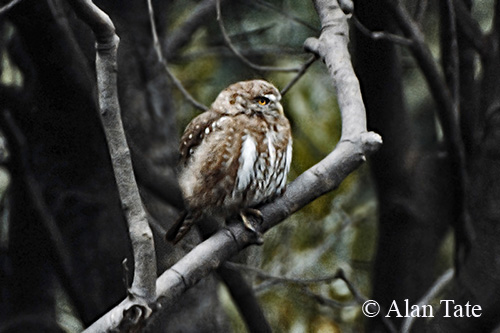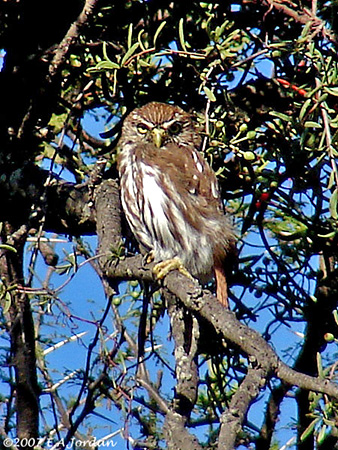
PROTECTION / THREATS / STATUS:
The Austral Pygmy-Owl is reported to be the most abundant owl in Chile.
It is persecuted in agricultural areas for its nocturnal calls interpreted as an ill omen. In the same areas, it is affected by the use of pesticides.
The size of the population is unknown, but it is suspected to be stable, without declines or important threats.
The Austral Pygmy-Owl is currently evaluated as Least Concern.
Fr: Chevêchette australe
Ang: Austral Pygmy-Owl
All: Australzwergkauz
Esp: Mochuelo Patagón
Ita: Civettina australe
Nd: Magelhaendwerguil
Sd: magellansparvuggla
Photographers:
Eduardo Andrés Jordan
MIS AVES – AVES DE ARGENTINA
Alan & Ann Tate
AA Bird Photography
Text by Nicole Bouglouan
Sources:
HANDBOOK OF THE BIRDS OF THE WORLD Vol 5 by Josep del Hoyo-Andrew Elliott-Jordi Sargatal - Lynx Edicions - ISBN: 8487334253
OWLS OF THE WORLD – By Claus König, Friedhelm Weick and Jan-Hendrik Becking - IBSN 978-0-7136-6548-2
Owls of the World: A Photographic Guide De Heimo Mikkola – Editeur: A&C Black, 2013 – ISBN: 1472905938, 9781472905932 – 528 pages
Field Guide to the Birds of Argentina and the Southwest Atlantic De Mark Pearman, Juan Ignacio Areta – Editeur: Bloomsbury Publishing, 2020 – ISBN: 1472984331, 9781472984333 – 480 pages
Field Guide to the Birds of Chile De Daniel E. Martínez Piña, Gonzalo E. González Cifuentes – Editeur: Bloomsbury Publishing, 2021 – ISBN: 1472987934, 9781472987938 – 224 pages
Diurnal Activity of the Austral Pygmy Owl (Glaucidium nana) in Southern Chile
DIET COMPOSITION OF THE AUSTRAL PYGMY OWL IN A PERI-URBAN PROTECTED AREA IN SOUTH-CENTRAL CHILE
New records indicate that Austral Pygmy Owl Glaucidium nanum breeds in eastern Patagonia
BIOLOGY OF THE AUSTRAL PYGMY-OWL
Wikipedia, the free encyclopaedia
Wikipedia, la enciclopedia libre
Austral Pygmy-Owl
Glaucidium nana
Strigiformes Order - Strigidae Family
INTRODUCTION :
The Austral Pygmy-Owl is found in South America, from Valparaiso Province in Chile and Neuquén Province in W Argentina, S to the tip of Tierra del Fuego.
It frequents a variety of habitat types including urban parks and farmland with scattered trees, and deciduous forests and thickets, also evergreen shrubland and scrub/steppes in Patagonia.
It typically feeds on insects, birds, mammals, reptiles and spiders, and sometimes takes large birds.
This species nests in natural cavities in trees or holes in banks. The female alone incubates the white eggs.
The Austral Pygmy-Owl is reported to be the most abundant owl in Chile. The species is not globally threatened at the moment.

On the head, the crown is warmer brown than the mantle, and often streaked. The facial disk is pale greyish-brown and finely streaked with white. Eyebrows and lores are whitish. We can see “false eyes” on the nape.
Bill and cere are greenish-yellow.
The eyes are pale yellow.
The tarsi are feathered whitish and mottled with greyish-brown.
The toes are yellow, with dark brown claws tipped blackish.
Male and female have similar plumage, but the female is slightly larger.
The juvenile resembles adult, but the crown is unspotted and the plumage pattern is less distinct.
The immature has deep yellow eyes with orange tinge.
The Austral Pygmy-Owl of red morph show similar plumage pattern, but the dark greyish-brown colour is replaced by rufous-brown.
Intermediates between greyish-brown and red morphs have been observed.

BEHAVIOUR IN THE WILD:
The Austral Pygmy-Owl is a solitary hunter. It is mainly diurnal but it can also be active at night.
Several authors say that this species preys primarily on birds such as White-crested Elaenia, Common Diuca Finch, Austral Blackbird, Austral Thrush, Rock Dove, and several other bird species including Plain-mantled Tit-spine-tail, Moustached Turca, Chilean Tinamou juvenile, Eared Dove and Domestic Fowl.
It has been observed taking birds almost double its own weight, and the size of the prey range from juvenile tinamous to hummingbirds.
But it also takes rodents such as the Common degu (Octodon degus) and domestic rats. Bats and insects are reported as secondary prey.
From some observations, when eating birds and mammals, the Austral Pygmy-Owl starts with the head, and sometimes eats only the brain.
Lizards and snakes are also taken, but reptiles and arachnids are a small part of the diet.
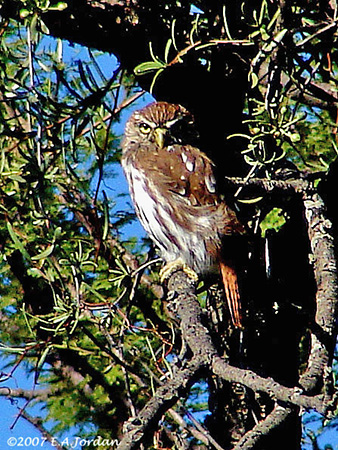
REPRODUCTION OF THIS SPECIES:
The breeding season takes place during the austral spring, between September and October.
The nest is placed in natural cavities, often an abandoned woodpecker hole in large tree or tree fork. But it may also be placed in earthen road bank, ground cavities like rodent burrows, and sometimes in buildings.
The nest is usually reused year after year, but we do not know if it is reused by the same pair.
The female lays 3-4/5 white eggs, and incubates alone during 15 to 17 days.
From some observations, the Austral Pygmy-Owl was recorded entering the nest cavities of other species with active nests and taking the chicks one after another. The nestlings of the owl were fed with avian and mammalian prey species, probably by both parents.
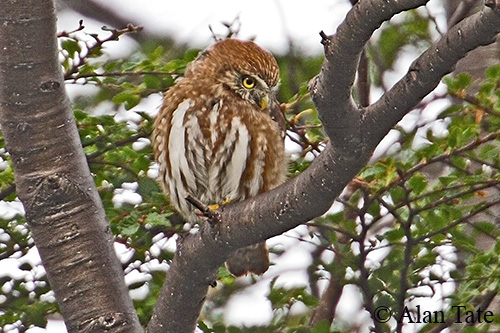
The southernmost populations of the Austral Pygmy-Owl migrate N in late autumn to N Argentina. The populations of southernmost Magallanes Region are permanent residents. The species is present year-round in SC Chile.
The Austral Pygmy-Owl flies silently, especially during the night while hunting. However, as a largely diurnal owl, the flight may be less quiet during the day.
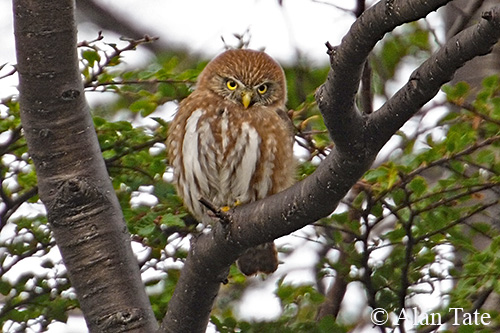
The Austral Pygmy-Owl forages, hunts and feeds solitary, stalking prey from perches throughout the day. But it is active both day and night. The prey is quickly killed with the powerful feet and strong talons.
During the breeding season, the male is very territorial and aggressive against other males. Mating and pairing occur during the austral mid-winter.
The male sings near a potential nest-site and then, sings from the entrance of the hole to attract the female. When she approaches, it utters an undulating cooing interspersed with clicking sounds.
The male may also deposit food inside the cavity and the female usually accepts the gift. The pair-bond is established.
The species typically nests in natural cavities in trees, banks, rodent burrows and occasionally in buildings. The nest is usually reused in several following years. This species lays a single clutch per season.
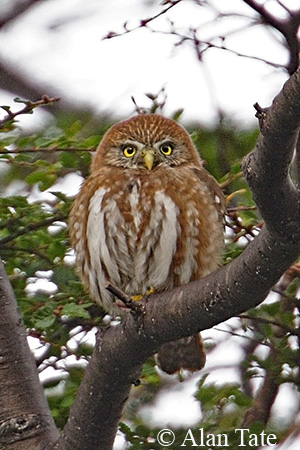
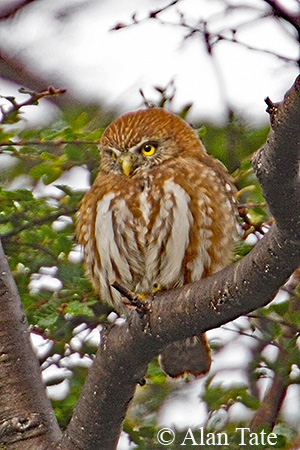
RANGE:
The Austral Pygmy-Owl occurs in S South America, from C Chile and WC Argentina, to the tip of Tierra del Fuego.
Some populations winter to N Argentina.
In Chile, the species is present from sea-level to 1,700, 1,800 and 2,000 metres of elevation, and in Argentina’s Patagonia, mainly around 1,500 metres.
HABITAT:
The Austral Pygmy-Owl frequents a large variety of habitats, including urban parks and gardens, and also farmland with scattered trees, deciduous forests and thickets. It is also reported in evergreen shrubland, especially in ravines.
It also occurs in temperate beech forests in S Chile, and mainly in Nothofagus forests in the southernmost part of Chile.
In Argentina, it also frequents Nothofagus forests and Patagonian scrub.
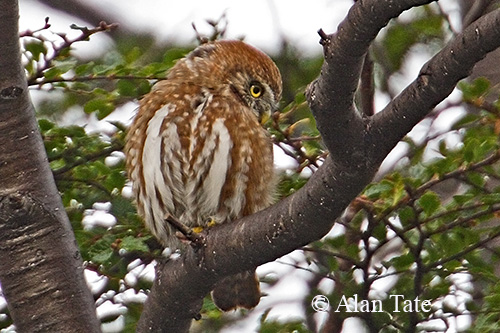
DESCRIPTION OF THE BIRD:
Biometrics:
Length: 17-21 cm
Weight: M: 56-75 g – F: 70-100 g
The Austral Pygmy-Owl has grey-brown and red morphs that intergrade between them. It is among the smallest owls in S South America.
The grey-brown morph has dark greyish-brown upperparts with whitish spots of variable size and shape. Mantle and back show irregular pale spots. On the scapulars, the outer webs show large white areas.
On the upperwing, the flight-feathers are dark greyish-brown, but several rows of whitish or pale buffish spots form an incomplete barring.
On the tail, the rectrices are dark greyish-brown with narrow buffy bars.
The underparts are whitish with dark greyish-brown streaking. The sides of the upper breast are dark greyish-brown and the white patch of the throat extends narrowly into the centre of the belly. The flanks are streaked whitish and dark brown.
